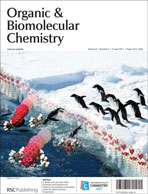Fumi Nagatsugi and Shuhei Imoto talk about recently developed novel cross-linking reactions in this emerging area.
This short review focuses on the crosslinking reactions using modified ONs (synthetic oligonucleotides) to react natural bases in duplexes and describes their recent work on the development of selective cross-linking reactions.
To have a good overview of the latest developments in cross-linking reactions to target genes using modified oligonucleotides download this review.
Induced cross-linking reactions to target genes using modified oligonucleotides
Fumi Nagatsugi and Shuhei Imoto
Org. Biomol. Chem., 2011, 9, 2579-2585
DOI: 10.1039/C0OB00819B











 Atsushi Ikeda and colleagues describe in this paper, which is the outside cover of
Atsushi Ikeda and colleagues describe in this paper, which is the outside cover of